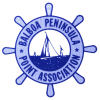History of Balboa
How It All Started
Under the Spanish, what we now call Newport Bay was known as Bolsa de Gengara, after Genga, the name of an Indian town near the present Costa Mesa. It became Bolsa de San Joaquin under Mexican rule. The Americans called it the San Joaquin Slough. There was no human habitation on the peninsula, the mesa to the west, or the San Joaquin Hills to the east. The primary feeder was the Santa Ana River. In September of 1860, the US Coast Survey schooner Humboldt anchored off the Balboa peninsula. Its skipper, Captain Greenwell, had a boat lowered and rowed into the opening of what is now Newport Harbor, which was about where F Street is now.
Greenwell “nearly lost his boat and crew” in the perilous swells of the inlet. He reported that the lagoon, five miles long, was “separated from the ocean by a narrow strip of sand-beach, over which heavy south-east and northwest swells wash in every gale.” Of the sandbar in the inlet, he wrote “Over this bar there is a frightful swell rolling and tumbling at all stages of the tide, making it dangerous to cross in boats of any kind.” Before he could complete a survey, he was recalled because of the Civil War.
In 1870, a small sternwheeler of very shallow draft, Vaquero, entered the bay to establish at Newport Landing a shipping business for grains, hides, and livestock, mainly from Irvine’s San Joaquin Rancho, which had originally been granted to Jose Andres Sepulveda and from Rancho Santiago de Santa Ana, owned by Don Bernardo Yorba. The Vaquero’s skipper, Captain Samuel S. Dunnels, declared that he had found a new port, the only port between Los Angeles and San Diego. Soon it became known as New-Port. In 1873, the McFadden brothers bought a small dock near Linda Isle and began a large trade importing lumber and exporting grain and wool. In 1875, they bad a steamer built, the Newport. In 1888, due to the difficulties of navigating the bay, the brothers erected an ocean pier, 1200’ long and 60’ wide, on the site of the present Newport Pier.
This made the wharves inside the bay obsolete. The McFaddens built a railroad to Santa Ana, completed in 1892. They laid out the town of Newport as a beach resort. The first hotel was opened near the Newport Pier in 1893. In the 1890’s, five to six hundred cargos a year landed at the pier, but by the early 1900’s, both pier and railroad had been acquired by Southern Pacific Railroad, which abandoned commercial shipping activity from the pier.
In 1902, W. S. Collins and A. C. Hanson purchased the town lots from the McFaddens. They announced that lots were available for $125, when fishermen and wharf workers were paid $2 a day. Not much happened until Collins replaced partner Hanson with Henry Huntington, nephew of Collis P. Huntington of Southern Pacific. The Huntingtons owned Pacific Electric, which operated the Red Cars, (One of the last of these trolleys is on view in Seal Beach). On July 1, 1905, the first Red Car reached Balboa. The Balboa Pavilion was completed soon after by J. P. Greeley, who had been Orange County Superintendent of Schools from its secession from LA County in 1884 until 1901. At the time, there was only one dwelling past what is now A Street. In the spring of 1905, Greeley realized that a hotel would be needed. He had a hotel built in ten days, on what is now the site of the Post Office on Main Street. There were a few houses in what is now downtown Balboa, but only one house to the east, which belonged to the land’s owner, Joseph Ferguson.
The name Balboa was selected by E. J. Louis, one of its developers. Gas and electric lines were installed in 1909. Telephone service started in 1907, with thirty subscribers and one line to Santa Ana. 1912 records show fifty telephone subscribers. In 1906, the towns of Newport, East Newport, and Balboa voted to incorporate as the city of Newport Beach. A 1937 city proposition to change the name of the city from Newport Beach to Balboa failed, 1014 to 581. Early in 1917, a trestle was built 1500 feet into the ocean from the tip of the peninsula, from which rocks were carried to build a jetty. In 1920, the outlet of the Santa Ana was diverted from Newport Bay directly to the ocean. By 1923, a huge sandbar had built up on the Corona del Mar side of the channel. Balboa Island was often awash, and shifting sands inside the bay made sailing an adventure. Getting in and out of the harbor was very dangerous, and many people died doing so. The depression changed that. Dredging in the bay had created a channel twenty feet deep, but at the harbor mouth, depth was often only two feet at low tide. In 1933 and 1934, government WPA and PWA projects created the jetty on the Corona del Mar side of the entrance, and the harbor was dredged. The sand was used to raise the level of Balboa Island, create Linda Isle, and significantly widen the ocean front beaches. By late 1934, the shapes of Newport Bay, Balboa Island, and the Balboa Peninsula had. become pretty much what they are today.
by Ralph Bernard
